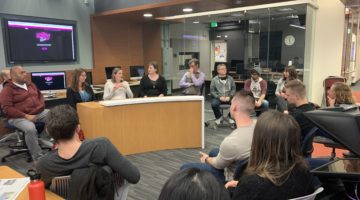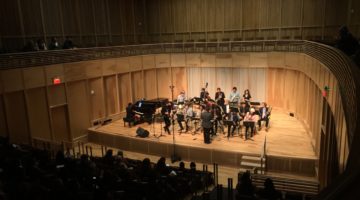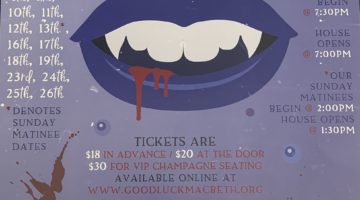
The second floor of the University Arts Building opens up to one of the entrances of the art galleries. This gallery is open, organized and pristine. Upstairs contains other works by the gallery, but on the second floor the walls are lined with Nolan Preece’s works, each with surreal color and patterns. Now, until December 20, the work of Nolan Preece can be observed in the John and Geraldine Lilley Museum of Art.
When first observing Preece’s works, one of the first things that can be seen are the lines and designs that make up most pieces. Across the left wall, most of Preece’s recent works are hung on display. Each of these works are unique and lack a clear description. They have an effect similar to that of a cloud. The longer you observe and take in each work by Preece, the more the chemigrams appear to take on different shapes and meanings.
Chemigrams are made by working from chemical-based prints without using a camera in the process. While Preece has done work in photography, chemigrams require a process that can include painting, printmaking and photography.
This style that Preece has developed looks vintage, abstract and alive. Preece’s recent works featured in the gallery had a large focus on blacks, browns and whites. Preece weaves lines into each chemigram that appear chaotic, but form greater images and shapes. With close inspection, shadowy figures, forests and other images can emerge from these lines. Most chemigrams also include what can more closely be described as amoebas, which are small, circular and broken up parts that each appear teeming with life. Some appear more like city blocks and small worlds that people live in—surrounded by the vast expanse of everything around them.
The varying styles of Preece include chemigrams, cliché-verve and gold-toned chemigrams. Cliché-verve follows a smooth and bright aesthetic. Preece uses this style to apply a wider variety of colors than his chemigrams such as pinks, purples, greens and blues. If a lava lamp and a bacterium were combined into a seemingly living image, then that would best describe some of his cliché-verves—almost like photos taken of another dimension where things are just a little too smooth and where everything moves a little bit off.
Only a few gold-toned chemigrams hung the walls of the exhibit, but they packed more of a guttural impact than any other. While the chemigrams were beautiful and abstract, a picture could be formed of what they could be with enough time. They were calmer and never felt aggressive or loud. Meanwhile, after a cursory inspection of the few gold-toned chemigrams, the atmosphere that is developed dissipates.
Two gold-toned chemigrams hung one above the other and left the largest impact on visitors. “A Simple Solution III” felt more imposing and intimidating than anything else in the exhibit. “A Simple Solution III” depicts cloudy bursts of brown from the edges of the chemigram that tries to distract from the large, unmoving, vertical, black rectangle that sucks in the focus of the viewer like a black hole. After only taking in the work for a few seconds, clenching in the stomach can be felt as it looms above and keeps drawing focus even after walking away as if it had an impossible gaze.
Preece expertly explores the beautiful, bizarre and terrifying with the audience’s imagination as an essential part of the experience. It is a great introduction to a type of art that isn’t as well known, but just as powerful. This exhibit is not for everyone—the chaos and abstractness captured on the walls is a far cry from traditional portraits and landscapes. It is worth a look and packs a real punch. Everything deserves more than just a glance as these pieces sometimes glance back.
Jayden Perez can be reached at ryleejackson@sagebrush.unr.edu, or on Twitter @NevadaSagebrush.












